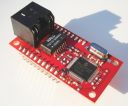Differences
This shows you the differences between two versions of the page.
| Both sides previous revision Previous revision Next revision | Previous revision | ||
|
en:netzer:boot2 [2012/03/16 14:39] svesch [Bootloader Version 2] Added 222. |
en:netzer:boot2 [2014/02/09 14:32] (current) |
||
|---|---|---|---|
| Line 8: | Line 8: | ||
| <WRAP center round download 60%> | <WRAP center round download 60%> | ||
| - | {{:bins:boot2.hex|Bootloader 2}}. Only installable with an external programmer device like ICD! | + | {{:bins:boot2.zip|Bootloader 2}}. Only installable with an external programmer device like ICD! |
| </WRAP> | </WRAP> | ||
| Line 14: | Line 14: | ||
| <WRAP center round download 60%> | <WRAP center round download 60%> | ||
| + | * {{:bins:140104_netzer_base.tar.gz|Version 1.5 base Build 1157}} (2014-01-04)}} | ||
| * {{:bins:120309_netzer.tar.gz|Version 1.4 base Build 222 (Release 2012-03-09)}} | * {{:bins:120309_netzer.tar.gz|Version 1.4 base Build 222 (Release 2012-03-09)}} | ||
| * {{:bins:120102_netzer.tar.gz|Version 1.4 base Build 220 (Release 2012-01-02)}} | * {{:bins:120102_netzer.tar.gz|Version 1.4 base Build 220 (Release 2012-01-02)}} | ||
| Line 32: | Line 33: | ||
| ===== Updates in operation mode ===== | ===== Updates in operation mode ===== | ||
| - | The update is done with a PC via the network. The hex file should be stored to hard disk before. The file is transfered to the Networker via tftp. For the update therefore a tftp client is needed. At the most operating systems such a client is included. | + | The update is done with a PC via the network. The hex file should be stored to hard disk before. The file is transfered to the Netzer via tftp. For the update therefore a tftp client is needed. At the most operating systems such a client is included. |
| - | Since Version 1.3 the Firmware update has to be explicitly activated via the Networker web interface (logged in as administrator). This eliminates a potential security risk of Networker. In the common settings a radio group can be found: | + | Since Version 1.3 the Firmware update has to be explicitly activated via the Netzer web interface (logged in as administrator). This eliminates a potential security risk of Netzer. In the common settings a radio group can be found: |
| {{ webinterface_permit_firmware_upload.jpg?nolink& |Webinterface screenshot}} | {{ webinterface_permit_firmware_upload.jpg?nolink& |Webinterface screenshot}} | ||
| - | The file is transfered to Networker with the TFTP PUT command. Networker is accessed via the current IP address or the network name. Example for a tftp command in a shell box under Windows: | + | There is also the possibility to activate the Firmware uploads from command line with **curl**: |
| + | <code>curl --data "ubf=1&O=Save" http://user:password@netzer_name.local/common.htm</code> | ||
| + | //netzer_name// must be the MDNS name of Netzer. Fill in administrator accounts data for //user// and //password//. Installed firmware without access control can simply use the following command: | ||
| + | <code>curl --data "ubf=1&O=Save" http://ne2c3519.local/common.htm</code> | ||
| + | |||
| + | |||
| + | The file is transfered to Netzer with the TFTP PUT command. Networker is accessed via the current IP address or the network name. Example for a tftp command in a shell box under Windows: | ||
| <code>tftp ne7C4000.local put "Netzer.hex"</code> | <code>tftp ne7C4000.local put "Netzer.hex"</code> | ||
| - | Networker goes into the update mode automatically and the file is transfered. A running transfer is indicated through the network activity LED, which is emitting for about 20 seconds. After the transfer has finished successfully the tftp client prints out that message: | + | Netzer goes into the update mode automatically and the file is transfered. A running transfer is indicated through the network activity LED, which is emitting for about 20 seconds. After the transfer has finished successfully the tftp client prints out that message: |
| <code>Transmission successful: 335139 bytes in 16 seconds, 20946 Bytes/s</code> | <code>Transmission successful: 335139 bytes in 16 seconds, 20946 Bytes/s</code> | ||
| Line 49: | Line 56: | ||
| ===== Updates in bootloader mode ===== | ===== Updates in bootloader mode ===== | ||
| - | The bootloader mode is active for aprox. 2 seconds after power on. After this time Networker enters the operation mode. The active mode is indicated due the fast blinking network LED. In bootloader mode Networker has the fixed IP address 192.168.97.60 and MAC address 00-04-A3-00-00-00. Updating only works if this IP address is not already occupied. The updating process works analog to the update in operation mode. | + | The bootloader mode is active for aprox. 2 seconds after power on. After this time Networker enters the operation mode. The active mode is indicated due the fast blinking network LED. In bootloader mode Networker has the fixed IP address 192.168.97.60 and MAC address 00-04-A3-00-00-00. |
| + | |||
| + | <note important>Netzer supports only ARP and TFTP in Bootloader mode, no ICMP. Hence, Netzer can **not** be pinged at 192.168.97.60.</note> | ||
| + | |||
| + | Updating only works if this IP address is not already occupied. The updating process works analog to the update in operation mode. | ||
| - | <note important>**Only one Networker is allowed to be in Bootloader mode when starting the update.**</note> | + | <note important>Only one Networker is allowed to be in Bootloader mode when starting the update.</note> |



